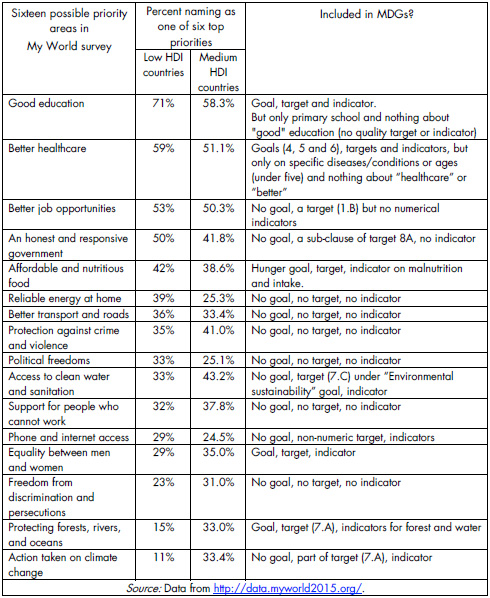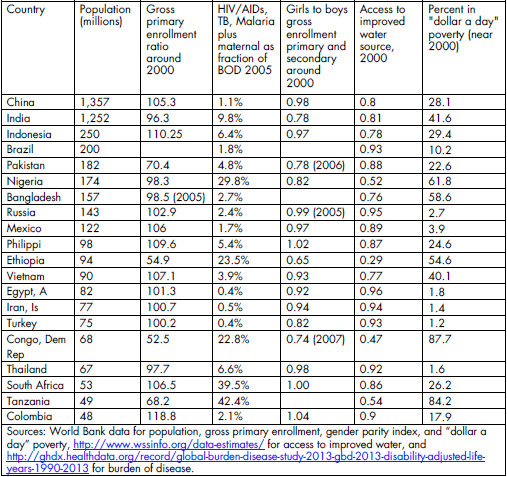written by Lant Pritchett
I think the SDGs are both worthless and yet worth it. My perhaps perverse view is that the SDGs are terrific because they will have no impact. The choices for a post-2015 UN development agenda were: (a) a “more of the same” extension of the MDG approach, (b) nothing, and (c) something like the SDGs. While one can debate whether the SDGs are slightly better than nothing or slightly worse than nothing, my argument is that even if the SDGs are worth nothing they are still far better than the MDGs.
The feature that many like about the MDGs, their focus, made them worse than nothing because they were focused on an agenda that was too narrow, too biased, and too kinky to be a global development agenda and this focus distorted development action and assistance.
MDGs too narrow and biased
Table 1 comparing the MDGs with priorities named by developing-country citizens shows the MDG domains were too narrow (excluding entire high-priority domains like energy and transport infrastructure, social protection, or good governance), had too narrow agenda even within those domains it named (schooling without learning, just a few diseases), and were biased toward rich-country and global hyper-elite concerns.
Table 1: The MDGs were narrow and biased compared to the expressed priorities of developing countries in the UN’s own “My World” survey

In connection with the preparation of the SDGs, the UN ran “My World,” a global survey that allowed people online (and with some other outreach to cell and paper surveys) to choose 6 of 16 possible issues as “most important for you and your family.” The process was obviously not representative and was potentially biased in a number of ways, but, unlike the MDGs, it allowed over 5.7 million people from low- and medium-HDI (human development indicator) countries to participate. Moreover, as part of a UN process, one would think the biases would be pro-MDG.
A comparison of these survey rankings (again, such as they are) against the official MDG goals, targets, and indicators shows just how narrow and biased the MDGs were. “Good education” is the most commonly named priority. While there is an MDG for education it lists only primary school completion, doesn’t happen to mention that education be “good,” or include anything about secondary or tertiary education.
“Better healthcare” is number 1, and health gets three goals but they are focused on specific ages, diseases, and conditions and never mention either “healthcare” or “better” for most disease conditions (see below).
The survey lists neither “economic growth” or “poverty” as possible priorities but “better job opportunities” is the number 3 named priority but, strangely, is subsumed in the MDGs as a target under the goal “Eradicate extreme poverty and hunger” without a numeric goal or target.
An honest and responsive government is the number 4 priority and merits only a vague mention in the MDGs.
Priorities 5, 6, 7, and 9 (among low-HDI country respondents) are infrastructure related — energy, transport, clean water and sanitation, and phone and internet access. Energy and transport are completely absent from the MDGs and water and sanitation are subsumed under “environmental sustainability” (as opposed to being important in their own right) and, more strangely still, phone and internet without a target bur have indicators under “global partnership for development.” As Leo (2013) shows representative survey results suggest that infrastructure is a large priority in Africa and Latin America.
The only target for goal 3 of promoting gender equality and empowering women was equalizing enrollments in primary and secondary school — nothing about sexual violence and domestic violence, nothing about property rights, nothing about discrimination.
The MDGs were too narrow a definition of development, with entire domains important to developing countries’ citizens like energy, transport, good governance and political freedoms, crime and violence, and social protection left out entirely. Even within the domains with an MDG like education, health and gender these were interpreted far too narrowly.
Too kinky
Kinky development is “defining development down” by setting a low bar for a goal and then claiming that reaching this arbitrary low bar is a priority. I call this “kinky” because a targeted project/program/intervention/policy that pushes everybody just up to a low bar level would produce a “kink” in the distribution of well-being at low bar level.
Table 2 shows the MDG targets were such low bar goals they were near being accomplished in the largest developing countries by the time MDGs started.
Table 2: The status of the MDGs before they started in most of the 20 largest developing countries—the targets were already mostly met because they were narrow and kinky

The top 20 most populous developing countries in Table 1 have 4.6 billion of the roughly 6 billion people in the developing world. Table 1 shows where these countries were on the MDGs roughly when (or just after) they started (as best data allows).
This table illustrates that the problem with the MDGs is not that they are not worthy goals but that the goals were too low to constitute a development agenda as they affected too few people.
Take access to an improved water source where the goal was to halve the proportion of people without access to safe water. In Pakistan in 2000, 88 percent of people were already using an improved source in 2000. This means improvements in water that benefitted only 6 percent of the people would be sufficient to meet the target. But only 28 percent of people in Pakistan in 2000 used water piped into their premise, which is a goal for nearly everyone and widely considered part of development but not included in the low-bar MDG. Too low bar.
Take gender. The target is just about equality of enrollment in primary and secondary school. In 10 of 17 countries with data this was already over 90 percent in 2000. But in Colombia where girls are more likely to be in primary and secondary school than boys, the DHS survey reports 44 percent of ever-married women have suffered from domestic violence by their spouse partner. The goal for “promoting gender equality and empowering women” is achieved without any mention of domestic violence? Too low bar.
Take education. All countries have many goals for education but the MDG had the narrow and low-bar goal just completing primary schooling — nothing about learning in primary school (or elsewhere), nothing about secondary, nothing about school to work transitions and training, nothing about higher education, nothing about research and knowledge creation — just completing primary school. As table 2 shows only 4 of these 20 countries had gross primary enrollment rates below 95 percent before the MDG started. Too low bar.
Take health. Besides the goal on infant mortality, the MDGs named HIV, tuberculosis, and malaria (Goal 6) and maternal health (Goal 5). These are obviously important and priority areas. But how narrow are these goals as a portion of (non-child) health? For this we only have data for 2005 but these diseases were less than 10 percent of all burden of disease in all but five countries and less than 5 percent in 11 countries. Three goals for health and nothing about access to health care? Too low bar.
What is the problem with development goals that are narrow, biased and kinky?
First, there is no line. A fundamental principle of Marshall’s Principles was that “nature doesn’t jump” and that is right: there is no non-linear jump in human well-being as these arbitrary low-bar thresholds are crossed. Nothing special happens to a child’s knowledge or capabilities at the end of primary school. Those more than 2 standard deviations below a norm of weight for age the WHO defines as “malnourished” but no one imagines that there is a dramatic difference between those at 2.1 and 1.9. There is no line at the poverty line — no one has ever held an “I am over $1.25 a day” party. Focusing on low-bar goals explicitly dismisses peoples’ legitimate aspirations for good education, better healthcare, higher incomes, better infrastructure as not “priority” without any rationale or justification for a cut off at a low bar.
The second problem is the MDG agenda is too narrow, biased, and kinky to be the development agenda of a democratically elected government. Democratic governments need the median voter and hence nearly all democracies have an agenda aimed at not just “the poor” but their broad middle class. This cannot be the MDGs. Take Indonesia, which made a democratic transition in 1999. The MDG on education could be part of, but not the main focus of its education agenda as primary completion was already at 95 percent. HIV, tuberculosis, malaria, and maternal mortality could be part of its health agenda — but that covered only 6.4 percent of its burden of disease. Access to improved water could be part of its infrastructure agenda, but 78 percent were already there. Equalizing enrollment could be part of a gender agenda, but rates were nearly equal already. By 2000 “dollar a day” poverty was already down to 29.4 percent (after spiking during the crisis) so that could not be their economic agenda — even though 67.1 percent were under the “two dollar a day” standard. As seen in Table 2 only for the very poorest of African countries could the MDGs broadly appeal as an agenda for the median voter.
Third, there is a fundamental contradiction between narrow, biased, kinky MDGs and the Paris Declaration that aid should be based on partner-country priorities. You cannot dictate both process and outcome: “countries should set their own priorities and these priorities should be the MDGs.” In nearly all developing countries, governments were increasingly saying to representatives of development assistance agencies: “Do you want to talk about our national agenda or the MDGs?” If one wants to maintain support for development assistance it has to have the support of the developing countries.
If a “mess” of “senseless, dreamy, garbled” “higgledy-piggledy” SDGs with “no priorities” are the price to pay to get rid of the focused but narrow, biased, and kinky MDGs and onto explicit goals, widely shared among citizens of developing countries, for economic growth (8.1) and higher poverty lines (1.2), learning in education goals (4.1), addressing systemic service delivery issues in healthcare and financing, access to energy (7.1) and expressing high-bar ideals rather than defining development down to low-bar goals then I am all for it — even if I don’t expect great things.